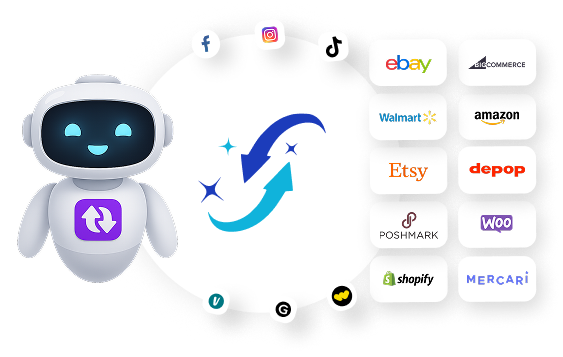The reselling industry continues to grow in 2025, with more sellers than ever are turning their closets, thrift store finds, and wholesale purchases into profitable businesses. Whether you're a casual seller looking to clear out unused items from your garage or an experienced reseller building a full-time income, choosing the right platform can make the difference between barely breaking even and running a thriving business.
With dozens of reselling apps and websites available, each with unique fee structures, audiences, and selling features, finding the platform that's right for your inventory and selling goals can feel overwhelming. Some reselling sites specialize in fashion, while others cater to collectors or general merchandise. Understanding where your products will perform best is the first step toward maximizing your reselling profits.
In this guide, we'll break down the best reselling platforms for sellers in 2025, compare their fees and features, and help you determine which best reselling websites align with your business model. Whether you're just getting started or looking to expand beyond your current platform, we've got the insights you need to sell smarter on any platform.
Key Takeaways
- Different reselling platforms are better for different product categories – fashion items perform best on Poshmark and Depop, for example, while general merchandise and collectibles tend to do better on platforms like eBay and Whatnot.
- Selling fees vary dramatically, ranging from 0% on some platforms to 20% on others. This directly affects your profit margins on every sale, which in turn impacts what you can sell and at what price.
- The most successful resellers typically use multiple platforms to reach a variety of different audiences, diversify their business, and maximize their earnings.
- Crosslisting tools have become essential for professional resellers who need to manage inventory across multiple sales channels.
10 Best Reselling Platforms for Online Sellers
In our experience, sellers who take the time to understand their options and choose the right platform for their inventory tend to be more successful, regardless of their starting point. The first step in finding the best reselling platform for your selling needs is familiarizing yourself with the various options you have as a reseller. Below, we've put together a list of the best reselling sites, covering a wide variety of reselling platforms – from online marketplaces to reselling apps that allow you to sell on the go – so you can make the best choice for your selling goals.

1. Poshmark
Poshmark has established itself as the leading social commerce platform for fashion reselling, with over 80 million active users. It's primarily focused on women's fashion, but also offers additional product categories such as home goods and children's clothing. The platform was one of the first to blend social media features with marketplace functionality, creating a unique selling environment where community engagement is an integral part of successful selling. Sellers who regularly share their listings, engage with other users, and participate in Posh Parties tend to see better results.
Sellers on Poshmark can list items as static listings at fixed prices, allow for bundling, where buyers can purchase multiple items from their store – called a Closet on Poshmark – at a discount, or send offers directly to buyers who've liked their listing. The platform also supports Posh Shows and Posh Party Lives, two similar yet distinct livestream selling methods where sellers showcase and sell items in real-time.
One major downside of Poshmark as a reselling platform is its high selling fees, which are among the highest in the reselling corner of the internet. Sellers pay a 20% commission on all sales over $15, or a flat $2.95 fee for sales under $15. Shipping is usually paid by the buyer, except in cases where sellers choose to offer free shipping, or on particularly heavy bundle orders.
Best For: Poshmark is best for fashion resellers with brand-name clothing and accessories who can dedicate time to the platform's social features and don't mind higher fees in exchange for an engaged, fashion-focused buyer base.

2. Depop
With its Instagram-style interface and emphasis on vintage, streetwear, and trendy secondhand clothing, Depop has carved out its niche as the go-to platform for Gen Z fashion enthusiasts. It typically attracts a younger demographic in comparison to Poshmark, with a more modest user base of around 30 million active users.
The selling process on Depop revolves around static listings, though sellers can negotiate prices through offers and counteroffers. Depop charges sellers a 10% commission on the total transaction amount, and gives them control over shipping by allowing them to ship independently or through Depop shipping.
High-quality photos are essential on Depop, as they help catch buyers' attention and showcase your items effectively. The platform's search algorithm prioritizes active sellers with relevant listings that are keyword-optimized. List items regularly, and remember to include aesthetic-focused keywords like Y2K, cottagecore, and grunge in your descriptions for better visibility. Ultimately, sellers who understand Depop's trend-focused culture and list items consistently see the best results on the marketplace.
Best For: Sellers with vintage finds, reworked clothing, curated and niche fashion collections, and alternative styles who are willing to put the work into building an active brand with keyword-optimized, visually cohesive listings.

3. Etsy
Unlike the platforms listed above, Etsy is not strictly a reselling marketplace. It caters to shoppers looking for unique, one-of-a-kind pieces, custom creations, and vintage items, operating as a specialized marketplace for selling only these types of goods.
Etsy allows for static listings only, where sellers set their own prices and create their own policies. Its selling fee structure is more complex than those typically found on reselling-only marketplaces like Depop and Poshmark, and listing on the platform itself incurs a fee. There is a $0.20 listing fee per item, plus a 6.5% transaction fee on the total sale price. Additionally, Etsy charges a 3% + $0.25 payment processing fee through Etsy Payments. To put this in perspective, you'd pay $5.20 (just over 10%) in fees on a $50 transaction – $0.20 to list, $3.25 in transaction fees, and $1.75 in payment processing. You can easily work this out with the help of our free Etsy fee calculator, and learn what your expected fees and earnings can look like for an average sale.
It's important to note that, while these fees can add up, the platform's focused audience is often the perfect opportunity for sellers to find buyers who are willing to pay a premium for the right piece.
Best For: Vintage resellers who can offer unique, authentic items that fit Etsy's definition of vintage (20+ years old). Vintage shoppers flock to Etsy for one-of-a-kind pieces, and are willing to pay premium prices for the perfect find.

4. Grailed
Grailed is the premier marketplace for buying and reselling menswear, streetwear, and high-end designer fashion. With over 10 million users and a curated marketplace that prioritizes quality and authentication, Grailed attracts buyers specifically looking for pieces from sought-after luxury brands like Supreme, Saint Laurent, Rick Owens, and Gucci.
Sellers can list items at fixed prices, while buyers can make offers that sellers can accept, decline, or counter. Grailed charges a straightforward 9% commission fee on all sales, plus payment processing fees of 3.49% + $0.49 for domestic transactions when using Stripe (Grailed's preferred payment processor). If you're interested in selling on Grailed and want to understand what these fees mean for your average order amount, run the numbers through our free Grailed fee calculator to get an idea of what your expected earnings could look like.
Best For: Resellers specializing in men's streetwear, designer menswear, limited-edition fashion, and high-end sneakers who can guarantee the authenticity of their items and align with Grailed's marketplace standards.

5. Vinted
Vinted stands out as one of the best reselling apps for sellers, with a fee structure that's almost too good to be true – there are no selling fees at all. Instead of charging sellers for selling through their platform, Vinted shifts costs to buyers through a Buyer Protection Fee, which covers payment processing, customer support, and fraud protection.
The platform focuses primarily on secondhand fashion and home goods, with a strong presence in Europe and growing popularity in the United States. Vinted uses static listings where sellers set their prices, though buyers can make offers which sellers can choose to accept or decline. Sellers can also create bundles, grouping multiple items together for combined shipping.
Because sellers keep 100% of their asking price, Vinted makes it easier to maintain their desired profit margins. The platform provides prepaid shipping labels to streamline fulfillment, though sellers still have the freedom to choose custom shipping options if preferred.
Best For: Fashion resellers looking to maximize profits on everyday clothing and accessories, especially those selling mid-range brands or items that would face high fees on commission-based platforms.

6. Whatnot
Whatnot has revolutionized the reselling space by combining live-streaming with ecommerce, creating an engaging shopping experience for collectibles enthusiasts. While the platform initially focused on contemporary collectibles like Funko Pops and trading cards, it has since expanded to include additional categories like vintage fashion, sneakers, and even sporting goods.
While livestream selling is Whatnot's standout feature, sellers can also choose to sell via static marketplace listings. During live shows, sellers can run countdown auctions that create excitement and competitive bidding among viewers, or opt for traditional fixed-price listings through the marketplace section, from which buyers can purchase anytime.
Whatnot charges an 8% commission fee on most categories (reduced to 4% for Coins & Money), plus a 2.9% + $0.30 payment processing fee calculated on the total order value including shipping and tax. Buyers pay for shipping, which is calculated based on the item's weight and destination. You can work out your expected profit on Whatnot with our free Whatnot fee calculator.
Best For: Resellers comfortable with live-streaming and creating engaging content, particularly those with collectibles, trading cards, vintage items, or limited-edition products that benefit from the excitement of live auctions.

7. eBay
As one of the first online marketplaces that gave the average person a way to resell their unused stuff, eBay continues to thrive as a versatile platform for selling virtually anything. With hundreds of millions of active buyers worldwide, eBay offers unmatched reach for resellers across countless product categories, from electronics and collectibles to fashion and home goods.
eBay provides sellers with multiple selling formats, including auction-style listings, fixed-price listings (Buy It Now), and a robust offer and counteroffer system (Best Offer) that can easily be automated with the help of the right eBay selling tool. Recently, eBay introduced eBay Live, a livestreamed selling format similar to Poshmark's Posh Party LIVE and Whatnot's livestream selling. This flexibility makes the platform particularly well-suited for selling a wide variety of items and reaching diverse buyer demographics.
In terms of selling fees, eBay remains relatively competitive, especially when compared to marketplaces in the reselling niche. Most sellers get 250 free listings per month before paying $0.35 insertion fees on additional listings. Final Value fees, paid only when an item is sold, range from approximately 12.9% to 13.6% for most categories, plus a per-order fee of $0.30 for orders under $10 or $0.40 for orders over $10. eBay also charges an additional 1.65% fee for international transactions. To put this into practical terms, for a $50 sale within the US and with no insertion fee, you can expect to pay a total of $6.85 to $7.20 in fees – between 13.7% to 14.4%. The fees include $6.45 to $6.80 in Final Value fees, plus an additional $0.40 order fee.
Best For: Resellers with diverse inventory across multiple categories, those looking for more variety in selling options, those comfortable with eBay's more complex fee structure, and sellers who want access to a massive, global buyer base for both new and used items.

8. Vestiaire Collective
Vestiaire Collective is a global reselling marketplace dedicated to buying and selling authentic pre-loved luxury fashion. The platform focuses exclusively on high-end designer items from brands like Chanel, Hermès, Louis Vuitton, and other luxury labels, making it a go-to for buyers specifically seeking genuine designer pieces.
Its rigorous authentication practices and standards set Vestiaire Collective apart from general reselling platforms. Every item listed goes through a verification process, either through detailed photo authentication or physical inspection at one of Vestiaire's authentication centers. This verification system protects buyers and sellers alike, allowing them to price authentic luxury goods at their true market value.
The platform operates on fixed-price listings where sellers set their own prices, though buyers can submit offers that sellers can accept or decline. As of 2025, Vestiaire Collective's fee structure includes a 12% commission on items priced between $83 and $16,667. Items below $83 carry a flat $10 fee, while items above $16,667 incur a flat $2,000 fee. All sales also include a 3% payment processing fee with a $3 minimum. Vestiaire provides prepaid shipping labels to simplify and safeguard the fulfillment process.
Best For: Resellers specializing in authentic luxury designer fashion, particularly those with high-end handbags, designer shoes, and premium accessories that can meet Vestiaire's authentication standards.

9. WooCommerce
Unlike the rest of the reselling platforms on our list, which until now has focused exclusively on reselling apps and sites, WooCommerce is not a reselling marketplace. Instead of allowing users to open a store that's hosted on a marketplace, WooCommerce is a shopping cart solution, which helps sellers build a completely custom, standalone webstore on their own website. As a free, open-source WordPress plugin, WooCommerce gives sellers complete control over their online store without having to abide by restrictive marketplace policies or paying marketplace fees on every sale.
With WooCommerce, you pay only for the costs of running your store – hosting, domain registration, and any extensions you choose to add (like advanced payment gateways or marketing tools). There are no listing fees, no commission fees paid to a marketplace, and no restrictions on what you can sell (within legal limits). You control your branding, customer experience, and pricing strategies without marketplace interference.
The trade-off is that you're responsible for driving your own traffic through SEO, paid advertising, social media, and other marketing channels. Unlike marketplaces, which offer sellers a base of interested shoppers that they must optimize individual listings for, webstores require more active work just to bring customers to your store. However, this also means you own your customer relationships and data, allowing you to build a loyal customer base and utilize retention strategies like email marketing.
Best For: Established sellers ready to build their own brand, those comfortable with basic website management, and sellers who want complete control over their store without paying ongoing marketplace fees.

10. Shopify
Like WooCommerce, Shopify is a webstore-building solution that gives sellers the ability to create and run their own custom webstore. Shopify is a complete, hosted ecommerce platform that handles all the technical details and offers a more structured, user-friendly approach in comparison to WooCommerce. It's ideal for sellers who want a simple, reliable, and accessible shopping cart solution, without having to deal with hosting, updates, or security concerns.
The platform offers a selection of built-in features like abandoned cart recovery, discount codes, gift cards, and extensive app integrations for added functionality. Shopify also provides professional themes designed specifically for ecommerce, making it easy for sellers to create a polished, mobile-responsive store without any technical expertise or coding knowledge.
Shopify operates on a monthly subscription model, with plans starting around $39/month, plus payment processing fees of approximately 2.9% + $0.30 per transaction when using Shopify Payments (their built-in payment processor).
Best For: Resellers who want their own branded webstore but are not tech-oriented, those interested in growing an independent brand, and those who don't mind paying a little more for a complete webstore package.
How to Choose the Right Reselling Platform
Selecting the best reselling platform starts with understanding your selling needs – in other words, what you sell and how you want to sell it. Different platforms cater to different product categories and selling styles, meaning that there's no single right platform for every type of reseller. Ultimately, understanding your reselling inventory, target customer, preferred selling methods, and overall selling goals is an essential first step in selecting the best reselling site for your business.
Start by considering your product category. Fashion items typically perform best on reselling platforms like Poshmark, Depop, and Vinted, while collectibles are more likely to find their audience on Whatnot and eBay. Even in the fashion niche, it's important to note that luxury designer pieces will be better appreciated on platforms like Vestiaire Collective and Grailed, and specifically vintage collectibles might be better suited for Etsy rather than Whatnot or eBay.
Another important consideration is your preferred selling style. Some platforms require more active engagement – Poshmark expects sellers to share listings and participate in community events, while Whatnot centers around live-streaming sales. If these selling methods are less suitable for you, consider reselling platforms like eBay and Vinted instead, which allow for a more hands-off approach once your listings are live.
Finally, consider platform selling fees, as they can vary dramatically across platforms and will have the most direct impact your bottom line. The range of selling fees in the reselling niche is vast – some platforms don't charge any selling fees, while others may take anywhere from 8% to 20% or more in total fees per sale. Knowing what to expect in terms of selling fees is essential for remaining profitable, no matter which reselling platform you ultimately choose.

Growing Your Reselling Business with Multichannel Selling
As we've seen, choosing the best reselling platform for your business comes with many considerations. If you're a new seller just starting out in the resale market, making the right decision can feel overwhelming. Luckily, you don't have to choose just one reselling platform; you can choose to sell on several platforms simultaneously with multichannel selling, and get access to the unique buyer demographics and benefits of each platform. Multichannel selling allows you to reach Depop's trend-focused Gen Z shoppers, Poshmark's brand-name fashion enthusiasts, and eBay's massive global audience – all with the same inventory.
Multichannel selling is not without its challenges, however. Managing inventory and listings across different platforms simultaneously can get complicated, especially when all your selling channels share the same inventory. Creating unique listings for every product on each marketplace, managing multichannel orders, and keeping inventory quantities synced to prevent overselling is an operation in and of itself, and quickly becomes overwhelming when sellers attempt to stay on top of these without the help of a multichannel selling solution like ExportYourStore.
ExportYourStore helps sellers handle the challenges of multichannel selling with AI-powered crosslisting and order management tools that make expanding to multiple selling channels simple and accessible. ExportYourStore's unique approach to multichannel selling allows sellers to designate any sales channel as their source store, which acts as the single source of truth for their entire multichannel operation. Any time you add new items to your inventory, you simply need to add them to your source store, and ExportYourStore will automatically crosslist them to your synced sales channels. With over 15 sales channels to choose from, including eBay, Poshmark, Depop, Grailed, Vinted, Whatnot, Mercari, Etsy, Vestiaire Collective, Shopify, and WooCommerce, you can easily sell on every major reselling platform simultaneously. With smart AI capabilities that handle everything from listing optimization to category mapping, ExportYourStore makes it easier than ever to not only crosslist products to new selling channels, but to give each product the best possible chances of success on every platform you list it on.
.png)
%20(1).png)
.png)
.png)
.png)
%20(1).png)
.png)
.png)
.png)
.png)
.png)
.png)
.png)
.png)




